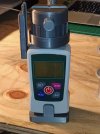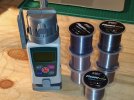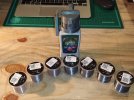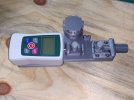777 Edge
Dealer / Materials Provider
- Joined
- Sep 16, 2019
- Messages
- 1,189
I'm in the final stages of designing two models of my "Leading Edge" edge testers. These could possibly be available on www.gritomatic.com in the near future.
My hope is that this would allow more knife enthusiasts to be able to get hold of a great and consistent edge tester for a very affordable price.
They will be more accurate (with very consistently repeatable results) than anything else on the market. These force meters have a resolution of 1g, and I've done extensive testing with various Fluoro Carbon line thickness. The best results (which yield numbers comparable to "standard" numbers from the Edge-on-up Bess tester), seem to be 0.2mm or 0.165mm Fluoro Carbon line. Using a new DE "Feather" razor blade as a calibration point, a 0.2mm line gives an average score of 30.5g. The 0.165mm line gives an average score of 21.9g.
My first version uses a force meter upright, and measures peak push force on the line when you push cut downwards (similar to Edge-On-Up). The numbers I mentioned above, is based on this version of my tester. I designed a locking washer with offset pin that will not rotate at all when the line is tightened. If you just tighten the test line with a thumb screw and washer (like the Edge-on-up tester), then the line tightness can end up being quite variable due to the rotation of the thumb screw when tightening - stretching the test line ever so slightly. I resolved this completely by designing a locking washer with pin under the thumb screw. I find the most consistent results with a line that is not stretched at all. It has to be very slightly slack, but straight.




My second version (Pic Below), is based on what some eastern European enthusiasts use. I use the force meter as a "pull force" measurement when cutting the line. You basically clamp the line in the 2 clamp screws, then tighten the small vise up to a set force value (I use 10g of pull force). Then you "zero" the force meter, set it in "peak" mode and measure the cutting force on the line. This version of the edge tester yields higher numbers (Feather DE blade about 50g on 0.2mm line). I assume this is due to the fact that the cutting force is downwards on the line, creating an offset vector. This version gives consistency in the fact that the line tightness can be adjusted, set and repeated exactly the same every time. The only difference is the fact that the test cut numbers are slightly higher than the "standard" we are used to.

My hope is that this would allow more knife enthusiasts to be able to get hold of a great and consistent edge tester for a very affordable price.
They will be more accurate (with very consistently repeatable results) than anything else on the market. These force meters have a resolution of 1g, and I've done extensive testing with various Fluoro Carbon line thickness. The best results (which yield numbers comparable to "standard" numbers from the Edge-on-up Bess tester), seem to be 0.2mm or 0.165mm Fluoro Carbon line. Using a new DE "Feather" razor blade as a calibration point, a 0.2mm line gives an average score of 30.5g. The 0.165mm line gives an average score of 21.9g.
My first version uses a force meter upright, and measures peak push force on the line when you push cut downwards (similar to Edge-On-Up). The numbers I mentioned above, is based on this version of my tester. I designed a locking washer with offset pin that will not rotate at all when the line is tightened. If you just tighten the test line with a thumb screw and washer (like the Edge-on-up tester), then the line tightness can end up being quite variable due to the rotation of the thumb screw when tightening - stretching the test line ever so slightly. I resolved this completely by designing a locking washer with pin under the thumb screw. I find the most consistent results with a line that is not stretched at all. It has to be very slightly slack, but straight.




My second version (Pic Below), is based on what some eastern European enthusiasts use. I use the force meter as a "pull force" measurement when cutting the line. You basically clamp the line in the 2 clamp screws, then tighten the small vise up to a set force value (I use 10g of pull force). Then you "zero" the force meter, set it in "peak" mode and measure the cutting force on the line. This version of the edge tester yields higher numbers (Feather DE blade about 50g on 0.2mm line). I assume this is due to the fact that the cutting force is downwards on the line, creating an offset vector. This version gives consistency in the fact that the line tightness can be adjusted, set and repeated exactly the same every time. The only difference is the fact that the test cut numbers are slightly higher than the "standard" we are used to.

Last edited:
